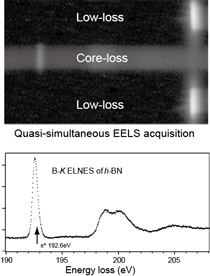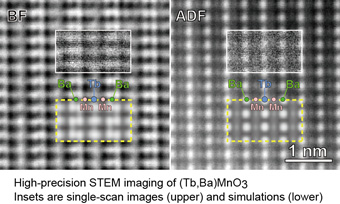DigitalMicrograph Scripting for EELS
 We published a paper entitled "Software Techniques for EELS..." in Journal of Microscopy (2002) [1], in which we improved practical energy resolution by "fast multiple acquisition and drift correction" technique. In addition, we demonstrated "low-loss and core-loss quasi-simultaneous acquisition" technique, which is similar to a recent Gatan's product, DualEELS; of course, the Gatan's product is more sophisticated hardware solution. To my knowledge, we are the first authors who wrote DigitalMicrograph scripts on a scientific journal. The title of the paper firstly submitted was not "Software Technique" but "Script Enhancement", which was not accepted by a journal referee because "Script" was not a general word in 2002.
We published a paper entitled "Software Techniques for EELS..." in Journal of Microscopy (2002) [1], in which we improved practical energy resolution by "fast multiple acquisition and drift correction" technique. In addition, we demonstrated "low-loss and core-loss quasi-simultaneous acquisition" technique, which is similar to a recent Gatan's product, DualEELS; of course, the Gatan's product is more sophisticated hardware solution. To my knowledge, we are the first authors who wrote DigitalMicrograph scripts on a scientific journal. The title of the paper firstly submitted was not "Software Technique" but "Script Enhancement", which was not accepted by a journal referee because "Script" was not a general word in 2002.
"Fast multiple acquisition and drift correction" is a common strategy to realize inherent performance of the system [2]. The same kind of approach was performed in other papers, in which full-flame CCD read-out is used as a shutter of the camera [3,4].
[2] Kimoto et al., J. Electron Microsc. 52 (2003) 299: Al ELNES.
[3] Kimoto, Kothleitner, Grogger, Matsui and Hofer, Micron 36 (2005) 185: Advantages of monochromator.
[4] Kimoto et al., Micron 36 (2005) 465: 0.23eV resolution using CFEG.
DigitalMicrograph Scripting for STEM/TEM Imaging

The procedure "fast multiple acquisition and drift correction" is also usable for TEM/STEM imaging, and we modified our scripts written for EELS in order to use them for STEM/TEM. We demonstrated the modified scripts in IMC meeting in Sapporo (2006), and published a few papers [5,6,7]. The scripts we prepared can improve not only the SN ratio but also the precision of the ADF imaging.
[5] Kimoto et al., Appl. Phys. Lett. 94 (2009) 041908: Detection of single Eu dopant atom in SiAlON developed by Dr. Hirosaki (NIMS).
[6] M. Saito et al., J. Electron Microsc. 58 (2009) 131: Detection of 10-pm atomic shift in (Tb,Ba)MnO3 synthesized by Prof. Kuwahara and Prof. Akahoshi.
[7] Kimoto et al., Ultramicroscopy 110 (2010) 778: High-precision observation and its limit of ADF imaging.
Now DigitalMicrograph scripting is very common as a research activity. For instance we prepared several scripts for spatially-resolved diffractometry, in which 4D data was converted to 3D data [8]. Quantitative ADF imaging implements probe current monitoring and the conversion of the non-linear response of the STEM detection systems [Yamashita et al. in print]. Since a multiple acquisition corresponds to a time dependence, we can elaborate a dynamic behavior of the material [9]. Multiple TEM acquisition is also useful for observing beam-sensitive materials [10]. Our first attempt to perform the assessment of TEM performance [11] was made using 3D Fourier transform, which was an in-house script, although now 3D Fourier transform is a standard function of DigitalMicrograph.
[8] Kimoto et al., Ultramicroscopy 111(2011) 1111: Spatially-resolved diffractometry with atomic-column resolution.
[9] Haixin Chang, et al., Scientific Reports 4 (2014) 6037: Single adatom dynamics on a reduced graphene.
[10] M. Ohwada et al. Scientific Reports 3 (2013) 2801: TiO2 nanosheet with Ti vancancy
[11] Kimoto et al. Ultramicroscopy 121 (2012) 31: 3D Fourier transform of through-focus images.
How to learn/deal with DigitalMicrograph (DM) scripting
There are lots of informative websites, and some of them kindly provide us their own scripts or packages, e.g., DM-Script Database of TU Graz [12]. Current DM help documents become full of information. In my view, DM scripting is very useful, but rather, addictive.
[12] DM-Script Database(TU Graz)